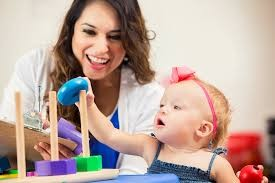Activities for Sustained Attention in Babies and Toddlers
- Dr. V.S. Gayathri
- Mar 17, 2021
- 3 min read
“Focus and concentration are the essential qualities for success.”
This mantra is something that we all learn to abide by right from our childhood and throughout our entire life. We often attribute the lack of attention as a factor behind success and failure. And, it is true to a certain extent.
In a study conducted among preschoolers, it was found that by the age of 4 years, as many as 40% of children have sufficient problems with attention to be of concern to parents and preschool teachers.
Based on research, a growing attention span has been determined based on the child’s age. The average attention approximately looks like this:
2 years old: four to six minutes
4 years old: eight to 12 minutes
6 years old: 12 to 18 minutes
8 years old: 16 to 24 minutes
10 years old: 20 to 30 minutes
12 years old: 24 to 36 minutes
14 years old: 28 to 42 minutes
16 years old: 32 to 48 minutes
However, the actual attention span for a child also depends on other factors like by factors like an external distraction, the interest of the child in the activity or task, and sometimes the physical state of the child. But if your child's attention span is way shorter than average, then that should be dealt with on priority.
There are different types of attention. For example, focalized attention refers to our ability to focus attention on a stimulus or selective attention is the ability to attend to a specific stimulus or action in the presence of other distracting stimuli. Now let us understand more about sustained attention.
What is sustained attention?
It is the ability to attend to a stimulus or activity over a long period of time. It is what makes it possible to concentrate on an activity for as long as it takes to finish, even if there are other distractions present. In real life, it is the need or ability to ignore a variety of distractions and inhibit attention shifts to irrelevant activities.
According to another study, the toddlers' use of help-seeking emotionally regulated strategies was positively related to sustained attention while avoidance behaviors and maternal behavior characterized by high levels of over-controlling or intrusiveness were negatively related to sustained attention at age 2. Moreover, maternal behavior with high levels of warmth/responsiveness also predicted greater growth in sustained attention from age 2 to 4.5 years.

Babies and toddlers are really energetic and probably won’t sit in one place. Their attention gets easily divided. However, prolonged engagement with your child in different activities can increase their interest and in turn their span of attention.
Now let us look at some of the activities which can help in sustained attention for babies and toddlers.
1. Sorting out Activity
You can choose objects like socks, mittens, or toys and ask them to sort according to colour, shape, or size. You need to demonstrate first and then be there to see if they are able to do it correctly. Gradually, they will be able to do without your assistance as their attention will be growing. Cheer them up every time they do it correctly.
2. Matching Activity
Again the same set of objects can be used, preferably which are in pair. You can mix them up and ask your child to match similar objects. It is advisable to use highly contrasting colours while choosing objects so that they can focus and match.

3. Playing with the ball
Every child loves to play with the ball and this is probably something that all parents play with babies and toddlers. This simple activity can help to enhance their attention because when you roll or pass the ball to them, they want to catch hold of it. Use a softball and start with rolling it with your baby. Gradually, they grow up, you can increase the pace or distance as well.
4. Threading beads
This activity surely needs a lot of attention and concentration. You can buy this toy for your baby or toddler and see how effectively they are able to do it. Use bigger beads for babies and maybe decrease the size (which increases difficulty level a bit) for toddlers. You can also use shoelaces for this activity for toddlers.

5. Clothespin
Clip the clothespin on the exact mark and help your child to put the clips. Gradually, let them do it on their own without your help. This is an excellent activity for developing fine motor skills as well.

It is always important to use multiple variations of activities. They might get bored with any one kind of activity. Hence, try a variety of activities according to their interests.




Comments